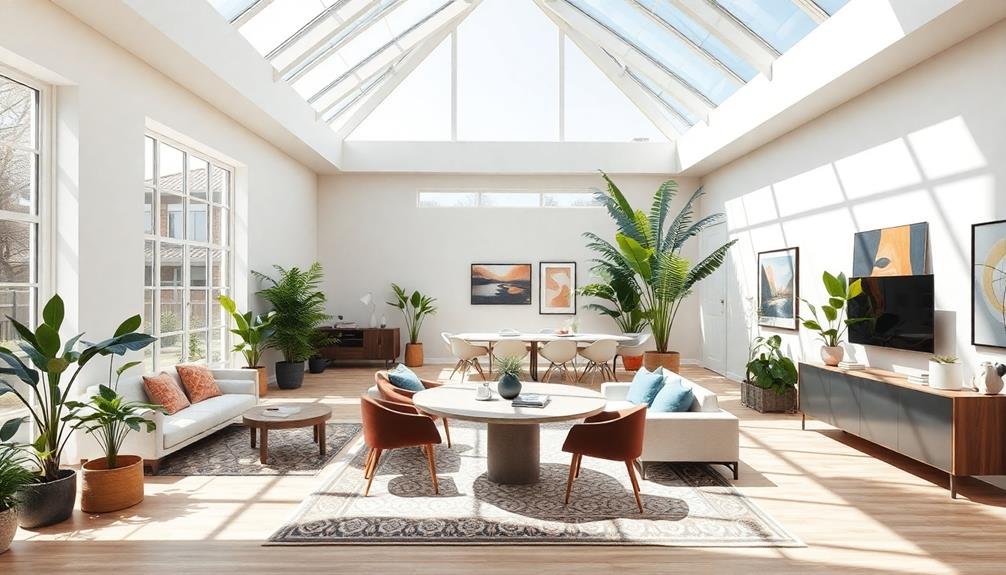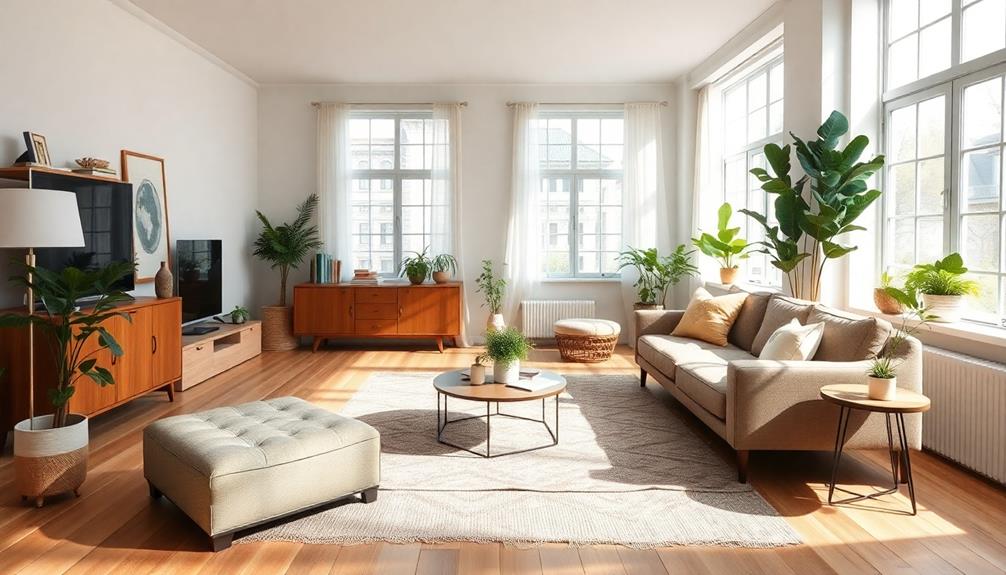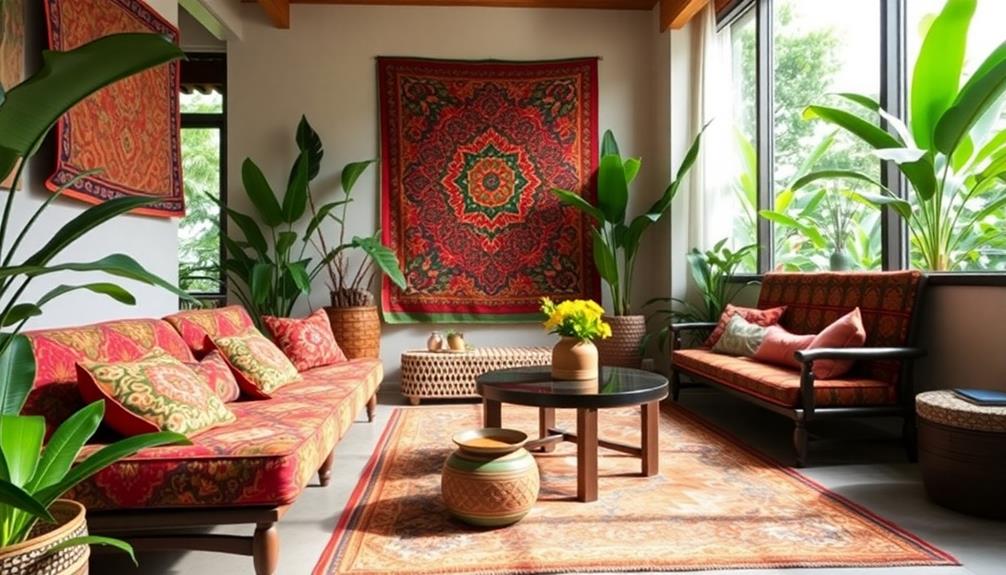To make interior decor work beautifully in open spaces, focus on enhancing connectivity and maximizing natural light. Start by defining distinct areas using smart furniture arrangements and area rugs, which foster conversation and create purpose. Incorporate multi-functional furniture to reduce clutter and improve flow. Choose a cohesive color scheme with neutral tones and consistent accent colors, and consider layering lighting for ambiance. Don't forget to integrate natural elements, like plants and natural materials, to create a warm atmosphere. Discover more tips and tricks to transform your open spaces into inviting and stylish areas that feel just right! For classic interior decor ideas that stand the test of time, consider incorporating timeless pieces like antique furniture or traditional patterns. Adding classic elements can bring a sense of elegance and sophistication to open spaces, creating a timeless and inviting atmosphere. By combining these classic interior decor ideas with modern touches, you can create a space that feels both timeless and on-trend. Whether you’re working with a small open space or a large loft, there are a few interior decor hacks that can help maximize the potential of your area. Utilize mirrors to create the illusion of more space and bounce natural light around the room. Additionally, strategic use of vertical storage can help keep clutter at bay and make the most of your available space. These interior decor hacks can help you make the most of your open space while creating a stylish and functional environment.
Key Takeaways
- Define distinct areas within open spaces using furniture arrangements and area rugs to promote functionality and interaction.
- Maximize natural light with large windows, light-colored walls, and strategically placed mirrors to enhance ambiance.
- Use a cohesive color palette with neutral base colors and consistent accent shades to maintain visual harmony across different zones.
- Incorporate smart storage solutions like multifunctional furniture and vertical storage to reduce clutter and enhance usability.
- Personalize your space with unique artwork and meaningful accessories that reflect your experiences and interests while maintaining a consistent aesthetic.
Understanding Open Floor Plans
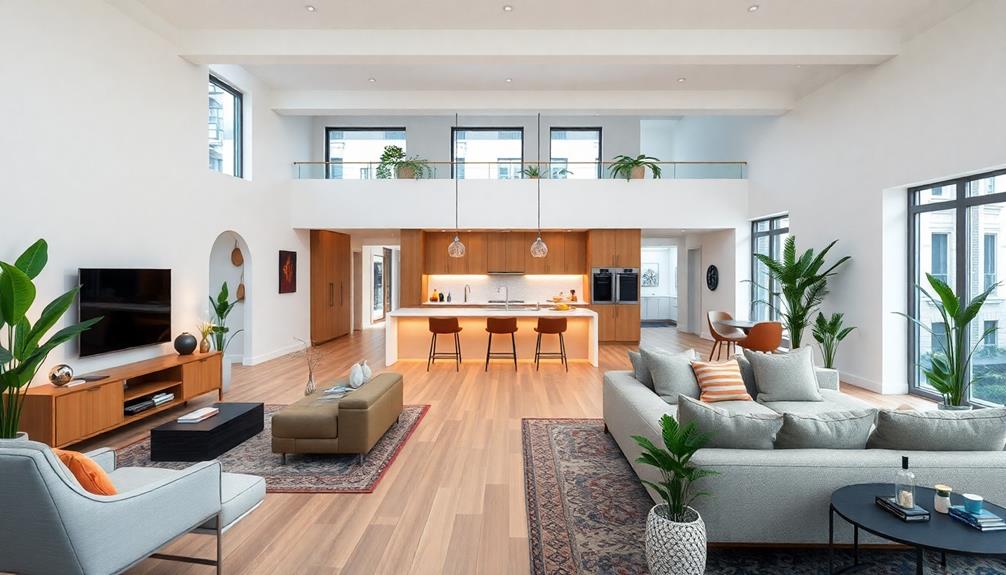
Open floor plans have become a popular choice in modern homes, as they eliminate walls and create a seamless connection between living, dining, and kitchen areas. This open concept living not only enhances connectivity but also encourages social interaction among family and friends.
Incorporating elements from different decor styles, such as combining aesthetic and nautical room decor, can further enhance the ambiance of these spaces. You'll find that these layouts maximize natural light, giving your space a bright and airy feel, which is ideal for homes of all sizes.
However, with the benefits come specific challenges. Noise control and privacy can become issues, and achieving a cohesive look is vital for visual harmony. To tackle these challenges, effective zoning is necessary. You can use furniture arrangement, color variations, and flooring differences to define functional areas within your open space.
Rugs are a great tool for creating defined zones, helping to visually separate spaces while adding warmth and texture.
When planning your open floor plan, consider movement patterns and natural pathways to enhance usability and guarantee an unobstructed flow throughout your home. By understanding these aspects, you can make your open concept living area both functional and aesthetically pleasing.
Benefits of Open Spaces

Open spaces bring a wealth of benefits that can transform your living environment.
You'll notice how enhanced natural light creates a warm, inviting atmosphere while promoting social interaction among family and friends.
With fewer walls, it's easier to connect and engage, making your home feel more alive.
Additionally, incorporating elements of indoor-outdoor living can further enhance the experience by blurring the lines between your interior and exterior spaces.
Enhanced Social Interaction
In a home designed with spaciousness in mind, social interaction thrives effortlessly. An open-plan space allows for seamless communication and movement among family members, breaking down physical barriers that can inhibit connection.
Imagine hosting friends in your large living room; the fluid layout encourages spontaneous gatherings, transforming casual get-togethers into memorable events. To enhance this inviting atmosphere, consider adding Indonesian decorative pillows that introduce vibrant colors and intricate patterns, making the space even more welcoming.
Studies show that homes with open floor plans can increase the likelihood of socializing at home by up to 20%, which highlights their effectiveness in fostering relationships. The visibility across various areas not only promotes engaging conversations but also makes it easier for you to supervise children while enjoying time with guests.
This enhanced interaction creates a lively, welcoming atmosphere where everyone feels connected.
Moreover, the design allows for a natural flow that enhances the overall vibe of your home, making it more inviting for both residents and visitors. With open spaces, the potential for social interaction becomes limitless, creating a dynamic environment that encourages family bonding and entertaining opportunities.
Embrace the benefits of your open-plan space, and watch your home transform into a hub of warmth and connection.
Maximized Natural Light
Maximized Natural Light (Benefits of Open Spaces)
Natural light plays a crucial role in enhancing the ambiance of your home, especially in open spaces where walls and partitions are minimized. By maximizing natural light, you create a warm and inviting environment that can uplift your mood and boost productivity.
Additionally, the integration of traditional Indonesian style home decor emphasizes harmony with nature, further enhancing the benefits of natural light. Studies show that increased exposure to sunlight can reduce stress and promote better sleep, making your home a sanctuary of well-being.
To fully enjoy the benefits of natural light, consider these design strategies:
- Large windows: They allow sunlight to flood in, making your spaces feel more expansive.
- Strategically placed mirrors: These can reflect light throughout your home, amplifying brightness and creating an airy atmosphere.
- Light-colored walls: Using soft hues enhances light reflection, contributing to a cheerful living environment.
Incorporating these elements in your open spaces not only elevates the aesthetic appeal but also fosters a sense of tranquility.
Embrace the power of natural light, and let it transform your home into a haven of comfort and energy.
Common Design Challenges

When designing a space that flows seamlessly, you may encounter several common challenges that can complicate the process. One of the primary issues is defining distinct areas within an open layout. To tackle this, you can implement zoning strategies through furniture arrangement and area rugs, creating functional zones without clutter.
Additionally, incorporating elements of Scandinavian charm can enhance warmth and safety, making the space more inviting for families.
Limited privacy can also be a drawback in open floor plans. Consider using strategic furniture placement or decorative screens to foster a sense of separation while preserving visual connectivity.
Another challenge is acoustics; open spaces often amplify noise levels, making it difficult to maintain a tranquil environment. You can mitigate this by incorporating soft furnishings and rugs that absorb sound, enhancing the overall comfort of your space.
Additionally, ensuring adequate storage solutions is essential. Open plans often lack traditional storage options, leading to clutter. So, look for creative storage solutions that blend seamlessly with your decor.
Lastly, lighting variations can disrupt a cohesive ambiance. Layering different light sources can help in achieving well-distributed illumination throughout the space, ensuring each area is both functional and inviting.
Color Schemes for Cohesion
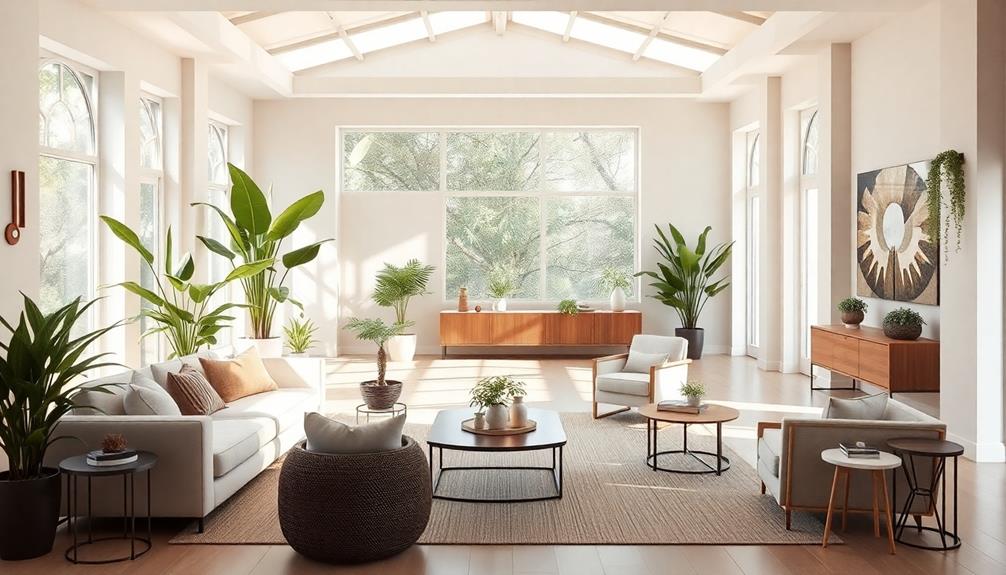
Creating a cohesive color scheme is essential for unifying open spaces and enhancing their overall aesthetic. When you choose a neutral color palette as a backdrop, it allows for versatility and minimizes the risk of clashing colors.
Additionally, consider utilizing sustainable home decor materials to enhance the beauty and eco-friendliness of your space. To truly tie the design together, incorporate a consistent accent color across various areas. This will maintain visual harmony and create a seamless flow between different zones.
To help you visualize a cohesive look, consider these elements:
- Area Rugs: Using rugs in a similar color scheme or material can visually define zones while keeping the overall design unified.
- Patterns and Textures: Repeat specific materials or patterns in your furniture and decor to prevent a disjointed appearance.
- Impactful Choices: Select a few standout textures and patterns to balance, avoiding overcrowding for a sophisticated look.
Defining Areas With Furniture

Defining areas with furniture is an effective way to enhance the functionality and flow of open spaces. You can achieve this by paying attention to your furniture arrangement, grouping sofas and chairs around focal points like a coffee table or fireplace. This setup not only promotes interaction but also creates distinct areas that feel purposeful and intimate.
In regions like Indonesia, where traditional homes often serve as community gathering spaces, the arrangement of furniture can reflect cultural significance and social interactions traditional Indonesian housing.
Area rugs are another essential element in this approach. They add warmth and help visually separate different functional zones, reducing noise and enhancing comfort. By placing an area rug beneath your seating area, you signal its significance while also softening the overall look.
Consider incorporating multifunctional furniture pieces, such as ottomans that double as storage. These items not only fulfill practical needs but also assist in designating areas without cluttering your space.
Smart Storage Solutions
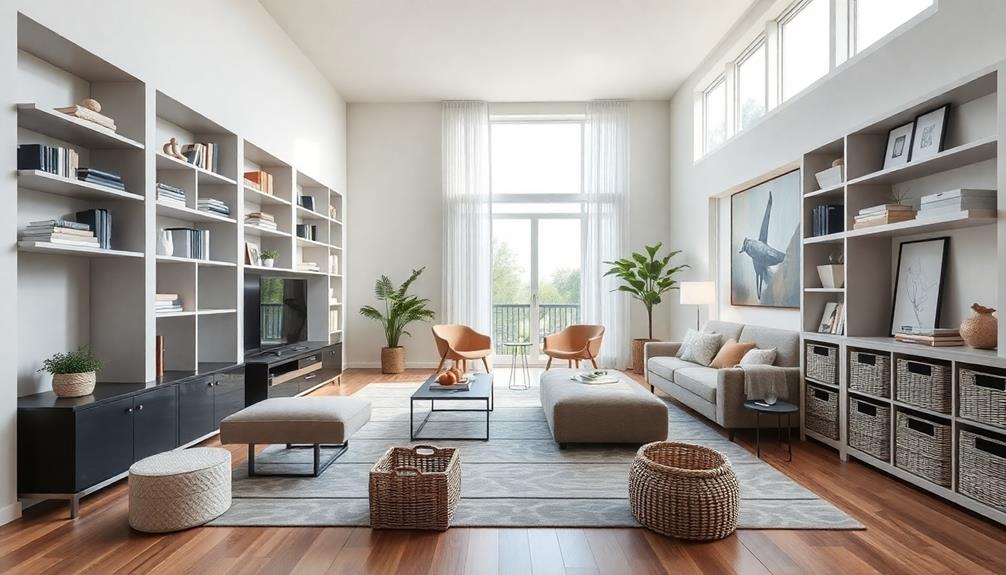
Smart storage solutions are essential for maintaining an organized and stylish environment in open spaces. You can effectively utilize vertical space with tall bookshelves and wall-mounted cabinets, which not only maximize storage but also keep your area looking sleek.
Additionally, consider enhancing your decor with unique pieces like an Indonesian decor mask that represents rich cultural heritage and can serve as a focal point in your space a must-have for cultural decor enthusiasts.
Embrace multi-functional furniture to blend practicality with aesthetics; consider options like:
- Ottomans with hidden storage for blankets or pillows
- Coffee tables featuring shelving for books or decorative items
- Semi-open shelving that displays your favorite decor while housing essential items
Don't overlook under-furniture storage either. Rolling bins or drawers tucked beneath sofas and beds can greatly reduce clutter, preserving the airy feel of your space.
For a touch of charm, incorporate decorative baskets and bins to store toys or miscellaneous items—this way, you combine style with utility.
Lighting for Ambiance

In open spaces, effective lighting plays an essential role in setting the mood and enhancing the overall ambiance. Layered lighting is key; combine ambient, task, and accent lighting to create a warm, inviting atmosphere while avoiding harsh shadows.
Consider using decorative elements inspired by local culture, such as traditional lanterns, which can add a unique touch to your lighting design while creating a cozy setting for gatherings, especially during evening events like Indonesian wedding decor ideas. Dimmable fixtures are your best friends here, allowing adjustable brightness levels that foster a cozy ambiance tailored to various activities and times of day.
Position low-hanging pendant lights over dining and sitting areas, serving as focal points that enhance intimacy and promote social interaction. They draw the eye and create a welcoming environment for gatherings.
Consider incorporating multiple light sources on individual circuits, enabling you to control each light source separately. This flexibility lets you adapt your lighting arrangement to different needs and moods throughout the day.
Don't forget about soft furnishings, like rugs and curtains, which can help mitigate echoes in open areas. They not only contribute to a comfortable environment but also enhance the overall acoustic balance, making your space feel cozy and inviting.
With thoughtful lighting choices, you can create an ambiance that truly makes your open space work beautifully for you.
Integrating Nature Indoors

Integrating Nature Indoors
Bringing nature indoors can transform your open space into a vibrant and rejuvenating oasis. By integrating elements of biophilic design, you can enhance your environment while boosting your well-being.
Consider these elements to create a harmonious connection between your interior and the great outdoors:
- Lush greenery: Incorporate potted plants and vertical gardens to improve air quality and add a burst of color. Adding popular varieties like the Snake Plant or Peace Lily can enhance the aesthetic while providing health benefits.
- Natural materials: Use wood, stone, and bamboo in your furniture and decor to foster a warm atmosphere that echoes nature.
- Soothing water features: Add indoor fountains or aquariums for calming sounds and movement, enhancing your connection to nature.
Maximize natural light and views with large windows and retractable walls, making your open space feel expansive and inviting.
Layer your floors with soft rugs to ground the design and create cozy, defined areas. Embracing these elements not only beautifies your space but also elevates your mood and productivity.
As you weave nature into your home, you'll find that your open space becomes a sanctuary that nurtures both body and mind.
Personalizing Your Space

Personalizing your space starts with unique artwork that speaks to your experiences and interests.
By choosing meaningful accessories and a customized color palette, you'll create an environment that truly reflects who you are.
Each piece you select adds to the story of your home, making it feel distinctly yours.
Unique Artwork Displays
Transforming open spaces with unique artwork displays not only adds personal character but also serves as enchanting focal points. By incorporating diverse art forms, you create visual interest that captivates guests and reflects your tastes.
Consider these engaging display ideas:
- Gallery Walls: Curate a collection of framed pieces in various sizes, showcasing your journey and interests.
- Oversized Pieces: Invest in a statement painting or sculpture that draws the eye and sparks conversation.
- Mixed Mediums: Combine paintings, textile art, and sculptures to create a dynamic and layered effect.
Using a consistent color palette or theme can harmonize your artwork with the overall aesthetic of your space.
Placing your pieces at eye level and in well-lit areas guarantees they're appreciated fully. Plus, don't forget to rotate your artwork periodically! This refreshes your decor, keeping it vibrant and allowing for seasonal themes or personal updates.
Embrace the beauty of unique artwork displays to make your open space truly yours, enhancing both the ambiance and character of your home.
Meaningful Accessory Choices
When you choose meaningful accessories for your open space, you not only enhance its aesthetic but also weave in your personal story. Selecting items like personal artwork or family photos infuses character into your environment, making it truly reflective of your individual style and history.
Consider incorporating unique collectibles or travel souvenirs; these not only serve as conversation starters but also make your space feel more inviting and personalized.
Emotional resonance is key, so think about using decorative items that hold significance, such as heirlooms or gifts from loved ones. These choices create a sense of belonging and warmth, particularly in larger areas.
To maintain a cohesive look, blend various textures through accessories like woven baskets or fabric throws. This adds depth and visual interest while ensuring your open space feels connected.
Lastly, aim for a consistent color palette with your accessories, including vases and cushions. This helps tie different zones together, enhancing the overall harmony of your open floor plan.
Customized Color Palettes
Choosing a customized color palette can dramatically elevate the ambiance of your open space. A well-curated palette enhances cohesiveness by using a consistent base color throughout. This allows for the integration of accent colors that resonate with your personal style, creating visual interest without overwhelming the design.
Consider these elements for your customized color palettes:
- Neutral color schemes that provide a versatile backdrop, reducing the risk of clashing colors.
- Varying shades of the same color to add depth and dimension, ensuring a seamless flow between different areas.
- Bold patterns or textures in select furniture pieces or decor that serve as focal points while adhering to a cohesive color strategy.
Frequently Asked Questions
How to Decor an Open Space?
To decorate an open space, define areas with rugs, choose multifunctional furniture, maintain a consistent color scheme, use various lighting sources, and arrange furniture to promote conversation and easy movement throughout the area.
How to Make Open-Concept Cozy?
To make your open-concept cozy, use area rugs for defined zones, incorporate soft textures like throws and pillows, arrange furniture for conversation, layer lighting for warmth, and personalize with artwork that reflects your style.
What to Do With Empty Space in an Open Floor Plan?
To fill empty space in your open floor plan, consider adding area rugs for warmth, multifunctional furniture for utility, and vertical storage for organization. Personalize with plants or artwork to enhance the overall aesthetic.
How Can I Make My Room Pretty Without Buying Anything?
Your room's potential is like a canvas waiting for color. Rearranging furniture, decluttering, and showcasing personal items can transform your space beautifully. Don't underestimate the power of lighting and rugs you already own.
Conclusion
By embracing these tips, you can transform your open space into a harmonious haven. It's funny how a well-placed plant can spark joy or how the right lighting can shift your mood. When you define areas with furniture, you might just stumble upon the perfect reading nook or social corner, unexpectedly blending function and style. Ultimately, it's about creating a space that reflects you, where every corner tells a story and invites connection.
